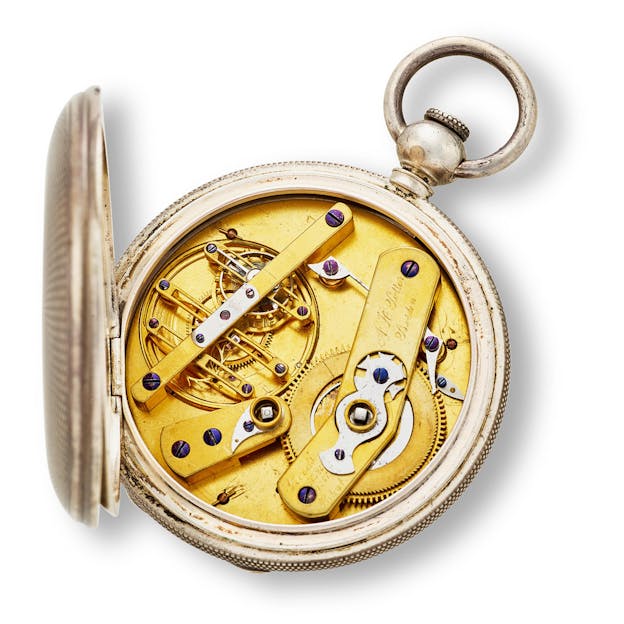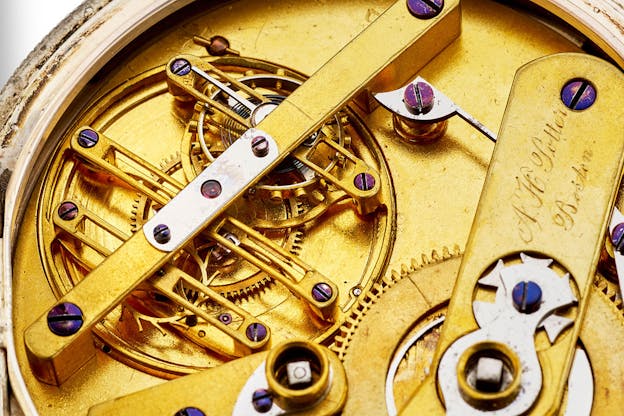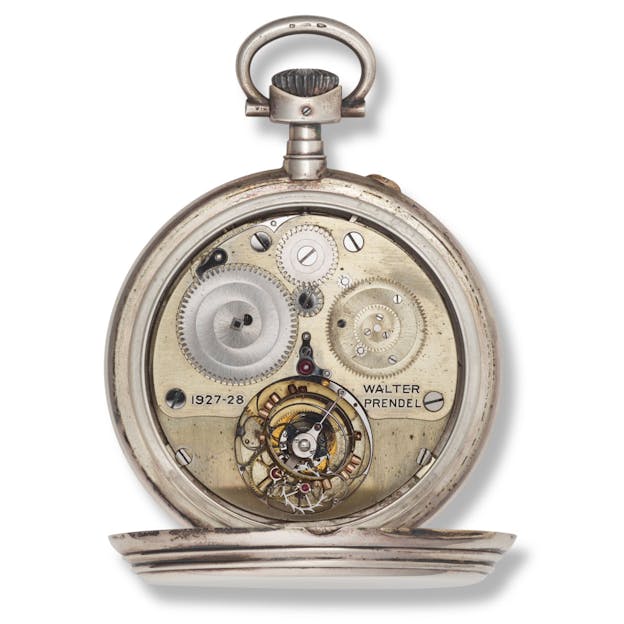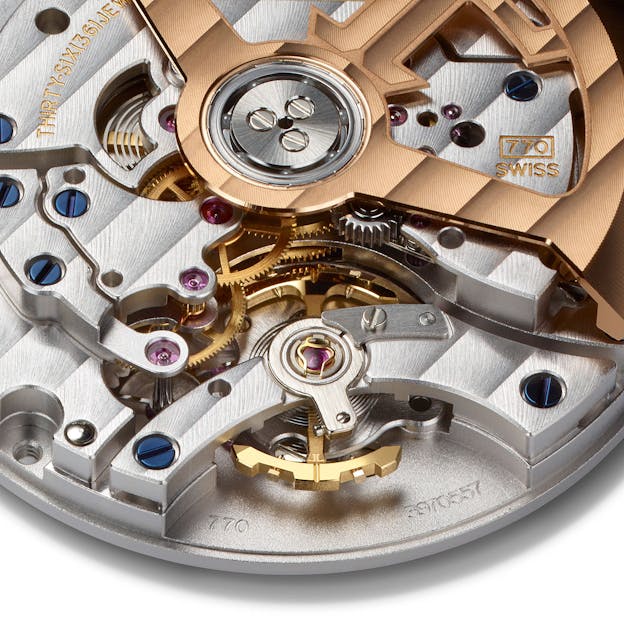In Defense Of Triple Axis Tourbillons: The Jaeger-LeCoultre Duomètre Heliotourbillon Perpetual
The latest multi-axis tourbillon from Jaeger-LeCoultre is a new chapter in a surprisingly long story.
The tourbillon began as an experiment. Breguet was well aware, as were other watchmakers pursuing portable precision timekeeping, that errors in poise, positional errors, and environmental factors like temperature variations could cause changes in the rate of a watch, and the tourbillon was an attempt to solve the problem of positional errors. The basic idea was to take the balance, balance spring, and escapement, and enclose them in a rotating cage, in order to produce a single average rate for all the vertical positions. One would then only need to adjust the flat positions to match this average rate and in theory, at least, you should have a perfect timekeeper. For most of its history, the tourbillon was an expression of both skill and the intention to pursue the greatest possible precision in a portable timekeeper – though they were difficult to make and challenging to adjust, they could provide exceptional results in the right hands.
The idea still seems a brilliant one, over 200 years later and although the tourbillon was for most of its history a great rarity, it has never stopped fascinating watchmakers and collectors as well. The past three decades have made the tourbillon much more widely known, thanks to its adoption as a de rigueur complication for any luxury watchmaker. However, as with anything else in watchmaking (and other things) how you do something is as important if not more important than what you do. In watchmaking, where for many decades inexpensive mechanical watches have been widely available, what has always distinguished fine watchmaking from industrial watchmaking has been attention to quality in materials and care in execution, and a really well-made tourbillon is still something to celebrate.

The Jaeger-LeCoultre Duomètre Heliotourbillon Perpetual brings together JLC’s Duomètre concept, with the latest in a long line of multi-axis tourbillons which the brand has been making since launching the Gyrotourbillon 1 in 2004. The Duomètre concept came along in 2007, and the series began with the Duomètre à Chronographe. The basic idea behind the Duomètre watches was to have two separate mainspring barrels – one would power the going train and the other would power the complications. The basic idea is taken from chiming complications – the grande sonnerie and minute repeater both have secondary spring barrels to power the chiming works. The Duomètre à Chronographe is a fascinating watch both conceptually, and to watch in action. There are two separate subdials for the time, and for the chronograph, with a center seconds hand and center chronograph seconds hand. The watch is also a foudroyante chronograph, with a 1/6th second hand that makes one full revolution per second.
Jaeger-LeCoultre would go on to expand the Duomètre series to include a number of different complications, including a couple of Sphérotourbillons – the latter are inclined, double axis tourbillons with an unusual motion, reminiscent of the precessing axis of a wobblng top.
The whole idea of multi-axis tourbillons arises naturally from the idea of a tourbillon and although they are largely a feature of the post-Quartz Crisis mechanical watch boom, the multi-axis tourbillon does have historical antecedents. The basic problem with the tourbillon is that it really only works as intended if a watch is in either a perfectly flat or perfectly vertical position and ideally, to eliminate (or at least, to reduce as much as possible) the effects of gravity on the rate of the watch, the tourbillon cage should rotate in such a way that the effects of gravity are averaged in any position.
The earliest known tourbillon with an inclined balance axis was made a surprisingly long time ago – an American watchmaker named Andrew H. Potter created one, with the balance staff inclined at about 25º, all the way back in 1857. (The watch is widely misattributed to Albert H. Potter).

That watch appeared at auction at Bonham’s in 2020, where it sold for $24,062.50, which seems incredibly inexpensive – someone got one heck of a piece of history.

The configuration of the tourbillon is unusual for another reason – you’ll notice that the balance is not on the same axis as tourbillon cage. AHCI co-founder Vincent Calabrese would use a similar configuration for the flying tourbillon he developed, which would subsequently be adopted by Blancpain.
The first tourbillon with an inclined axis for the cage was completed 71 years later, in 1928, by the German watchmaker Walter Prendel. Prendel studied at the watchmaking school in Glashütte under Alfred Helwig, inventor of the modern flying tourbillon, and this watch sold at Christie’s in 2021, for CHF 150,000.

As you can see, the idea itself is not especially new – at least as long ago as 1857 it had occurred to someone, as indeed it may have to Breguet himself, that it was possible to take the theory behind the tourbillon even further, but even standard tourbillons were sufficiently difficult to produce, and moreover, the gains offered versus the challenges involved in making a tourbillon were probably relatively small enough that attempting to make a double or triple axis tourbillon seemed too daunting to attempt to most watchmakers.
The idea was however, periodically revisited and in 1977, the first double axis tourbillon was patented by Anthony Randall, with a working model made by Richard Good in 1980. The first triple axis tourbillon was made by Thomas Prescher in 2004, which was also the same year that Franck Muller introduced its triple axis Revolution 3 – and of course, it’s the year Jaeger-LeCoultre launched the Gyrotourbillon 1.
Inclined axis tourbillons and multi-axis tourbillons differ in their technical details but the basic rationale behind them all is the same – to prevent the timekeeping components from being in the most extreme positions where the effects of gravity on the rate of the watch are most pronounced.
I bring all this up to point out that while the tourbillon today is largely pursued for its entertainment value, there is more than that to the history of multi-axis tourbillons, and it’s that history that’s the context for the Heliotourbillon Perpetual.

The heart of the Heliotourbillon is its triple axis tourbillon. This consists of three titanium cages nested inside each other.

Jaeger-LeCoultre describes the arrangement as follows: “The first cage is set at a 90-degree angle to the balance wheel and rotates perpendicular to it. The second cage is set at 90 degrees to the first (thus, on the same plane as the balance wheel). Together, these two cages are constrained by an axis tilted at 40 degrees and make a full rotation in 30 seconds. The third cage is perpendicular to the second and makes a full rotation in 60 seconds. Supported on ceramic ball bearings to minimise friction, the tourbillon consists of 163 components and weighs less than 0.7 grams.”
The balance spring is cylindrical – cylindrical balance springs were originally invented by the English watchmaker John Arnold, who was granted a patent in 1776. Arnold was a close friend of Breguet and there is circumstantial evidence at least for him having come up with the idea for the tourbillon, although of course it was Breguet who built the first, as far as we know, and it was Breguet who patented the idea. The presence of the cylindrical balance spring in the Heliotourbillon perpetual is a combination therefore of two inventions from two of the most important watchmakers of the last couple of hundred years, both of whom were pioneers in precision timekeeping (Arnold had invented the cylindrical balance spring for use in marine chronometers).

Generally, the Duomètre watches are symmetrical around the vertical axis of the dial, with subdials on either side; alternatively, they can be constructed with an aperture on the left to allow a complication to be viewed, as was the case with the Sphérotourbillon and Duomètre à Grande Sonnerie. The Heliotourbillon follows the latter formula, with an aperture on the side of the case to allow the triple axis tourbillon to be seen more easily. The tourbillon’s nested cages are set against a background of stars (and a seconds track – the outermost tourbillon cage rotates once every sixty seconds, and has three small red arrows on its periphery, allowing 20 second intervals to be read off). The star background is a reminder that the perpetual calendar is, in fact, an astronomical complication inasmuch as it’s necessitated by the length of the Earth’s orbit around the Sun, and the name of the watch is a shout out to the celestial nature of the complication as well – Helios was the Greek god of the Sun.

As with the other Duomètre watches, the power from the two mainspring barrels is divided between the complication and the timekeeping train. There are two power reserve indicators, just as in the other Duomètre watches.
There is one other interesting technical feature of the Heliotourbillon, which is the balance.

As you can see, it’s not a conventional annular (ring shaped) balance. Instead, the balance rim is a series of segments, with four sections set slightly inside the outer edge; these sections carry the timing screws. It took me a few minutes to realize where I’d seen something like this before – in 2007, JLC produced an experimental watch called the Extreme LAB, which had a number of unusual technical features (for one thing, it used no conventional oils; the balance pivots used a dry lubricant called molybdenum disulfide). The balance itself was also unusual – it was slightly reminiscent of De Bethune’s non-annular balance, in that it consisted of two arms with two separated crescents. JLC called it the Gyrolab balance and the company used it in 2015, for the launch of the Geophysic True Second.

I’m not entirely sure why JLC chose this particular configuration for the balance in the Heliotourbillon – the cylindrical balance spring would preclude the use of a conventional regulator, so some sort of adjustable mass balance would seem a necessity. JLC last used this balance in the Reverso Gyrotourbillon Tribute, launched in 2016 and which had a hemispherical balance spring. It’s possible that the balance in the Heliotourbillon needed to be smaller in order to fit inside the three nested tourbillon cages and the bridges between the segments holding the timing screws were added to keep the balance inertia high enough for good timekeeping.

Certainly this is one of the most technically interesting watches JLC has produced in recent years, and it touches some remarkable moments in the history of the tourbillon in general and Jaeger-LeCoultre’s history in particular. Complicated watchmaking can be a lot of things but one very important role it can play – whether you are a client for this sort of thing or not – is to remind us how much creativity has been born out of the consequences of some of watchmaking’s most perennial problems.
I have heard some of JLC’s multi-axis tourbillons spoken of dismissively in recent years, and that’s understandable up to a point; it takes some willingness to dig to understand the background behind this sort of thing, and a certain amount of work as well. The benefit however, of keeping an open mind and a willingness to work from the premise that a company like Jaeger-LeCoultre doesn’t produce watches like this in a vacuum, is a combination of intellectual and aesthetic pleasure you can really only get from fine watchmaking.
The Jaeger-LeCoultre Duomètre Heliotourbillon Perpetual: case, 18k pink gold, 44mm x 14.7mm, with sapphire crystals front and back. Movement, JLC caliber 388, hand wound, with 46 hour power reserve from each mainspring barrel; Duomètre movement with separate power trains for timekeeping and the perpetual calendar. Functions: time, perpetual calendar with big date and four digit year display, moonphase and power reserve indications. Limited edition of 20 pieces worldwide; price at launch, $438,ooo. Find out more at Jaeger-LeCoultre.com.

